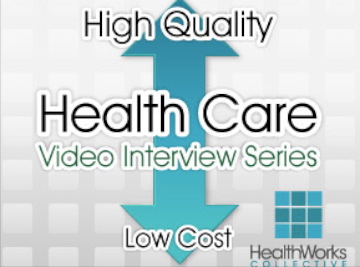
Last week, we heard from John Holland at AMC Health talk about remote patient monitoring in discharge planning, chronic disease care and clinical studies. Today, Herbert Ong, President and CEO of Healthentic talks about Corporate Wellness Programs and how Healthentic can help employers better manage workplace health.

Last week, we heard from John Holland at AMC Health talk about remote patient monitoring in discharge planning, chronic disease care and clinical studies. Today, Herbert Ong, President and CEO of Healthentic talks about Corporate Wellness Programs and how Healthentic can help employers better manage workplace health.
Healthentic gathers data, analyzes it and creates clear strategies for the employer. Healthentic’s Wellness Decision Engine offers 4 steps to effective workplace health.
- Keep the healthy, healthy
- Understand you company’s health
- Understand risks and trends
- Take back control of your company’s wellness
For a very clear, short and EXCELLENT demo, please click here!
And now watch the interview!
To see other videos in this series, please go to this page. And if you have a story to tell that can reduce healthcare costs and raise quality of care, please comment below or email me at joan@socialmediatoday.com Thanks!
Video transcript (by TranscriptionStar)
Joan: Hello. This is Joan Justice with HealthWorks Collective, and I’m here today with Herbert Ong, President and CEO of Healthentic. Healthentic plans to transform wellness in the workplace by gathering data and helping employers better manage their wellness programs. Herbert Ong has a background in healthcare business and information technology, and he cofounded Healthentic with the mission to control healthcare costs and outcomes. Herbert tell us a little bit about Healthentic and its mission?
Herbert: Great. Thank you so much Joan and I appreciate this opportunity. This is a topic that I’m very passionate about love many times if we can talk. Healthentic is very passionate about helping employees and people in general to improve their lives for the better. We think that you can do that in two ways.
One is using the power of data to really understand who is the folks that are most at-risk and needs to have prevention by the way. And two combined that with the power of elegant design. It has to be something that and its actually actionable and useful by the people, the employers out there to actually implement at programs. So as a company these are the two things that we’re focused on.
What we’re — what we have is a product called the Wellness Decision Engine. It’s a tool that helps employers make decisions on wellness, but for the first time using data. What makes it really different is three things. The first thing is that its co-health [0:01:31] so we’re one of the only companies we know of that not only takes medical data and pharmacy data, will take historical claims data, but we also combine it with dental data.
Joan: I saw that.
Herbert: We’ve combined health risk assessments biometric data. We have a partnership with IBI to actually do productivity reports. We also have a partnership with Vision in getting vision data in the tool, and we have — basically we’re looking at all sorts of data to truly identify the population at most at-risk. We call that whole health. The second thing we do is we go beyond reporting.
We interviewed a 138 bank managers, and the first year I really tried to find out what is their biggest pain points and beyond the fact that they’re already getting all these reports from the medical care, dental care, their vision care, their brokers’ consultants, salon vendor. They wanted so that I could see it, but there’s actually nine steps that employers go through before they see healthier employers and lower cost.
Step one is reporting you know what is this health status of my employees, but then they need to understand you know I ask bank managers what you know do you know even today how many if you’re pulling your company is healthy how many at-risk, how many have a chronic condition. More importantly do you know the health migration, do you know who used to be healthy last year that is health at [Indiscernible] [0:02:57].
Who is going to be next year’s catastrophes? If you know the risk migration more importantly do you know what was the key political drivers that cause that because if you have limited time, limited dollars, you want to spend your time on the chronic disease, but you also want to focus your time on the people that are getting worse, and who — what are the key critical drivers.
Joan: And how can you stop it yes of course.
Herbert: How can you stop it? Once you know that do you actually know all the different strategies that employers implement to actually address these particular hot spots that you might be having.
Joan: So you show them the strategies too.
Herbert: We help with the strategies and we actually give them one quick business cases and CEO presentations to get approval that’s the number one problem that we found that many [Indiscernible] [0:03:44] who are administrators trying to become wellness that they can’t even get their where the course approve it. I mean give them these business cases to get approval and then we give them the actual do-it-yourself material for large the foundation of wellness programs that they need to have employees like a small free environment or a fruits on the table, but also very specific ones for every specific mediation not adherence for diabetic or the kidney disease.
Once you actually know that, do you actually know the wellness vendors and what your carriers provided services for you? Who are the wellness vendors you would call if you have a problem with smoking cessation? Who are the wellness that you would call that their kidney disease is screening [Crosstalk].
Joan: Okay so you offer the math too. You offer them wellness vendors a list of wellness vendors great.
Herbert: Right and then once he actually implement the program which is just one of those steps you actually have an ability to track the success of that program with Success metrics. Can you course correct not way two years later to find out the — whether or not the program worked or not, but actually no every single quarter, every single month, every single week whether or not your activity metrics, your outcome metrics, your action metrics are all improving or not.
So you know as a product what we decided to do is not only for health, but we go beyond reporting in an elegant design and a very, very now affordable that any employer can actually implement this program for all sizes whether you’re fully ensured or self ensured whether or not you have access today or you don’t. We have a version of the product that helps you go through these nine steps, but the most important thing is that you implement in management platform right so if you want to lose weight or I want to lose weight the first thing we should do is by a scale and find out where it doesn’t need data so the spark is available for size and floors even if you’re 30 employees 50 employees.
The power version is employers typically that is a 150 employees and higher our suite spot is the 1000 to 10000 employee size and even general employers are finding significant value in what we’re offering as well. We have one price for this. It’s a $1 per employee per month that which is very affordable because if you’re spending $650 per member per month on your chronics. If who do spend $1 per employee per employee per month just be able to get [Indiscernible] [0:07:29] platform tracks to success.
So the other question you ask was you know how do we know this is successful. You know what we — what I say is that as an employer you don’t just implement one wellness program and expect that its going to succeed. You should have a suite of programs targeted at a specific hotspot you’ve identified and I — yet I mentioned that you want to target the people that are getting worse that are risk migrations specific.
You don’t just do one program. You do a suite of programs, so one example is we found out that you know there’s one company had a lot of diabetics, great. We found out that they had more diabetic hyperlipidemia so core morbidity than they did diabetic hypertension and they have a lot of diabetic periodontal disease so for that population you want to implement diet programs not just hypertension programs. You want to implement dental programs not just diabetic programs as well, so a suite of programs number one.
Two, do you have the foundational programs in place. It’s the only one I hear about employers. We’re doing at this helpers assessment and then you ask that why was it not successful and part of the reason is that well, they hadn’t yet implemented a smoke free environment. They hadn’t yet implemented a smoke free environment. They hadn’t yet implemented a basic well that fruits you know diet program in the company or actualized program. They haven’t had their executives approve a kind of start participating in communicating the importance of wellness to the company.
So when then they implement the health for assessment it becomes something that the employees think that you’re doing for your benefit not for the employees benefit. You know two you need to measure success of these programs. So you know without these kinds of things in place it’s the likelihood of being successful is not, it’s not as [Indiscernible] [0:09:17].
Joan: And how many, how many clients do you have at the moment Herbert?
Herbert: Right still we have — we just launched the company four years ago and we launched the Wellness Decision Engine and after expensive interviews with 140 bank managers the first two years. And this year we now have 40 employers who purchased the product from us. We have 22 brokers and consultants across the nation who are purchasing the product. 90% of the time they buy from us and we gave it to their employers for free.
We have 12 dental plans representing fifth states who are our customers and distributing our products for us, and we have their partnership with a micro carrier today and we think that that’s actually going to broke because many medical care they’re finding significant value in both of our versions of our product, so we’ve — because we’ve shown that everybody in an ecosystem is finding something really interesting about what we’re offering and its really interesting.
We actually even have partnership with two wellness vendors as well. We think that that’s going to grow significantly overtime as well.
Joan: Sounds great. Thank you so much Herbert. I think you’ve given our readers a really good idea of what Healthentic can do and wellness programs and management of health in the workplace are going to become increasingly important and Healthentic seems like it can really help. Thanks so much.
Herbert: Thanks you Joan. I appreciate and I just remind everybody that this is really personal. There are people that are getting sick and you could prevent it from happening and there are your wives, there are your husbands, you know friends and family so it’s really important that we solve this problem. Thank you so much Joan.
Joan: Thank you.








